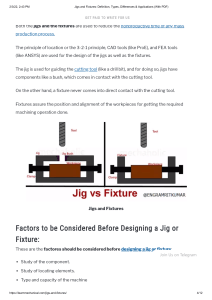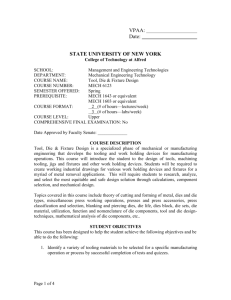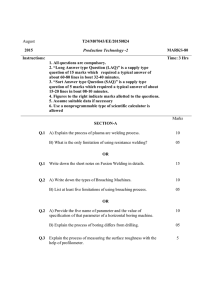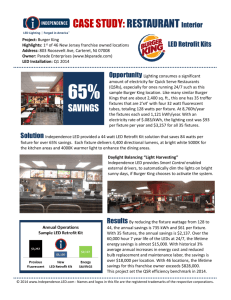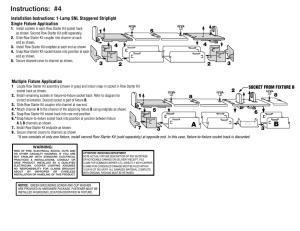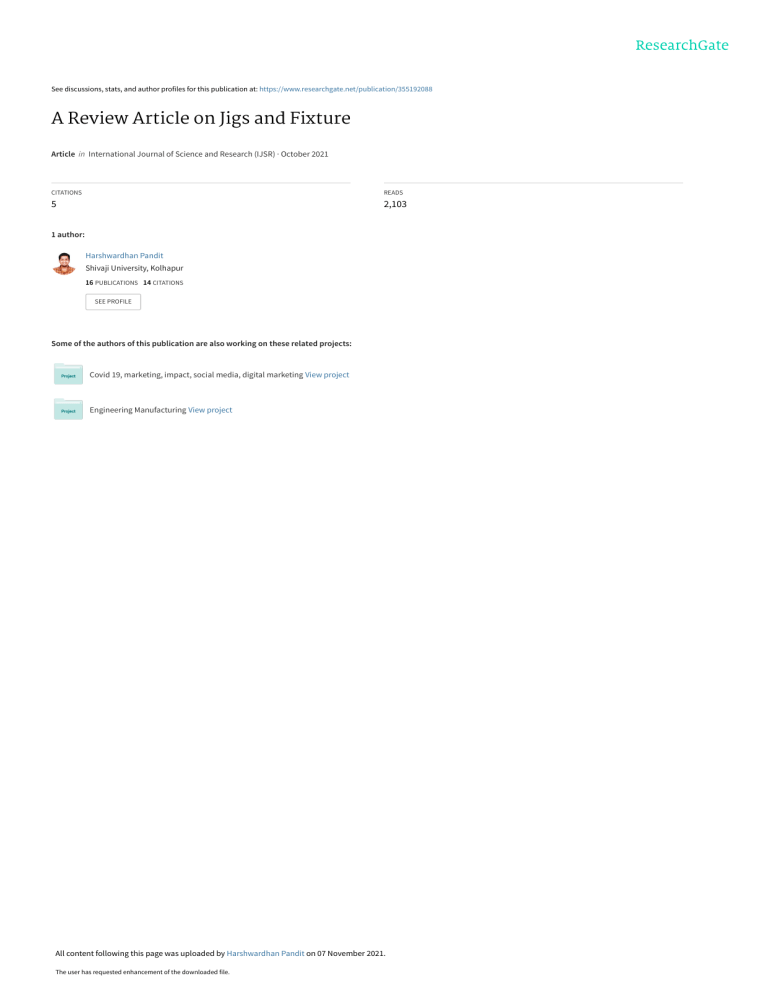
See discussions, stats, and author profiles for this publication at: https://www.researchgate.net/publication/355192088 A Review Article on Jigs and Fixture Article in International Journal of Science and Research (IJSR) · October 2021 CITATIONS READS 5 2,103 1 author: Harshwardhan Pandit Shivaji University, Kolhapur 16 PUBLICATIONS 14 CITATIONS SEE PROFILE Some of the authors of this publication are also working on these related projects: Covid 19, marketing, impact, social media, digital marketing View project Engineering Manufacturing View project All content following this page was uploaded by Harshwardhan Pandit on 07 November 2021. The user has requested enhancement of the downloaded file. International Journal of Science and Research (IJSR) ISSN (Online): 2319-7064 Index Copernicus Value (2015): 78.96 | Impact Factor (2015): 6.391 A Review Article on Jigs and Fixture Jayesh Vijaykumar Kumbhar1, Harshwardhan Chandrakant Pandit2 1,2 Mechanical Engineering, Department of Technology, Shivaji University, Vidyanagar Kolhapur, Maharashtra (India) Abstract: The paper gives a detailed definition of jigs and fixtures, and also identified the numerous advantages that are associated with the use of jigs and fixtures in manufacturing to include: production increase, cost reduction, interchangeability and high accuracy of parts, reduction of the need for inspection and quality control expenses, reduction of accident as safety is improved, automation of machine tool to an appreciable extent, easy machining of complex and heavy components, as well as low variability in dimension which leads to consistent quality of manufactured products. Fixture is required in various industries according to their application. This can be achieved by selecting the optimal location of fixturing elements such as locators and clamps. The fixture set up for component is done manually. For that more cycle time required for loading and unloading the material. Keywords: Components, Work-Holding, Manufacturing, Production, Drill Bushes 1. Introduction To locate and immobilize workpieces for machining, inspection, assembly and other operations fixtures are used. A fixture consists of a set of locators and clamps. Locators are used to determine the position and orientation of a workpiece, whereas clamps exert clamping forces so that the workpiece is pressed firmly against locators. Clamping has to be appropriately planned at the stage of machining fixture design. The design of a fixture is a highly complex and intuitive process, which require knowledge. Fixture design plays an important role at the setup planning phase. Proper fixture design is crucial for developing product quality in different terms of accuracy, surface finish and precision of the machined parts In existing design the fixture set up is done manually, so the aim of this project is to replace with hydraulic fixture to save time for loading and unloading of component. Hydraulic fixture provides the manufacturer for flexibility in holding forces and to optimize design for machine operation as well as process functionability [2]. A jig for the aforesaid purpose has been designed and developed under the project Niche Area of Excellence, Farm Mechanization in Rainfed Agriculture, at Faculty of Agriculture Engineering workshop. It ensures the interchangeability and thus the farmers can replace and repair components without losing appropriate time during weeding operation. Mass production aims at high productivity to reduce unit cost and interchangeability to facilitate easy assembly. The fixture is a special tool for holding a work piece in proper position during manufacturing operation. For supporting and clamping the work piece, device is provided. Frequent checking, positioning, individual marking and non-uniform quality in manufacturing process is eliminated by fixture. This increase productivity and reduce operation time. Fixture is widely used in the industry practical production because of feature and advantages.[1] 2. Review The traditional jigs and fixtures proved helpful in increasing the production units per unit time, saving the time consumed in the process. The thorough study of the entire process, it was found that all the above mentioned parameters can further be improved with the help of improved jigs and fixtures. Hence, the designing of dies helpful in the production of paddy weeder was done with the help of designing software solid works shown in Figure 5. Once the designing was done, the jigs were developed[3]. One die was designed and developed for creating 90˚ bends on the MS plates. Fig1shows the generated designs for the production. Hence, eliminating the need for joints made and reducing the amount of welding operation performed. For creating the float, having an semi-elliptical shape, a set of fixtures were also designed between which, plates are placed and so pressed that the shape for the float is created.[1] Figure 1: Simple Fixture Figure 2: Open Type Jig Working simultaneously by more than one tool on the same work-piece was possible. There was no need to examine the quality of output, provided that quality of employed jigs and fixtures was ensured. The hand operated jigs for molding the MS plate in right angles and moulding plate for development of float of paddy weeder is developed. The rate of welding got halved with the use of improved jigs, with the traditional jigs the welding was needed 12 times and now welding was completed in only five times, resulting in saving of time and material used, hence reducing the costs associated with production. Figure 4 shows the hand operated press and the frame developed with its implementation.[2] Volume 6 Issue 4, April 2017 www.ijsr.net Licensed Under Creative Commons Attribution CC BY Paper ID: ART20173037 2467 International Journal of Science and Research (IJSR) ISSN (Online): 2319-7064 Index Copernicus Value (2015): 78.96 | Impact Factor (2015): 6.391 Figure 3: Lathe Fixture 3. Conclusion Both the jigs and the fixtures are used to reduce the nonproductive time of any mass production process. The principle of location or the, tools, and FEA tools (like ANSYS) are used for the design of the jigs as well the fixtures. The jig is used for guiding the cutting tool (like a drill bit), and for doing so, jigs have components like a bush, which comes in contact with the cutting tool. On the other hand, a fixture never comes in direct contact with the cutting tool. Fixtures assure the position and alignment of the work pieces for getting the required machining operation done. References [1] Ali, M. and Mahalle, G. (2013). Design and analysis of weight lever drilling jig. International Journal of Pure and Applied Research in Engineering and. Technology 1(8): 177-186. [2] Midhun.R, Vignesh.A,Design and Fabrication of Jigs and Fixtures for Drilling Operation, International Journal for Scientific Research & Development| Vol. 3, Issue 12, 2016 | ISSN (online): 2321-0613 [3] Guohua Qin, Weihong, Zhang Min Wan “Analysis and Optimal Design of Fixture Clamping Sequence ASME for publication in the JOURNAL OF MANUFACTURING SCIENCE AND ENGINEERING, 2006. Volume 6 Issue 4, April 2017 www.ijsr.net Licensed Under Creative Commons Attribution CC BY Paper ID: ART20173037 View publication stats 2468
